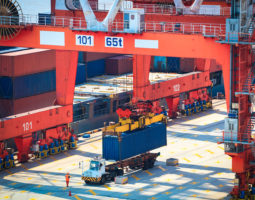Adam Hill: Freight Rates Are Pay to Play Following Pandemic Upheaval

Adam Hill, President and COO of Scarbrough Global
“I don’t think we’re going to get back to the pre-pandemic freight rates,” President and COO of the Scarbrough Group Adam Hill said. “In fact, I kind of hope we don’t.”
Hill, a 15-year veteran of international supply chain management and self-proclaimed brokerage nerd, had blunt words to describe his predictions for post-pandemic logistics.
The unprecedented disruption of the novel coronavirus pandemic has sent global supply chains reeling. From displaced cargo containers to soaring freight costs and atypical volume surges, the logistics circumstances have forced logistics operators to change their tactics. According to Hill, falling back to the pre-pandemic environment is unlikely.
“It’s going to be different,” he said simply.
Freight Rates Have Risen Dramatically; Don’t Expect Them to Drop
For starters, Hill pointed to the dramatic growth in maritime freight rates. Transit costs have skyrocketed over the last year with little reprieve on the horizon. While some are hopeful for a return to lower pre-pandemic rates, Hill predicts that costs will remain high but consistent.
“I think the new standard will be more expensive than the old one. You’re not going to see those sub-$1,000 rates to Los Angeles anymore,” Hill said. “You have to be willing to pay to play.”
In Hill’s words, this is the first time that we have seen rates grow coming out of major disruptions. Usually, volatility means the bottom will drop out on rates. This time it has gone the other way.
“During the recession, you could get containers to Los Angeles for $500,” Hill stated. “This time around we’re seeing rates north of $8,000 to get a container to LA. It’s just insane.”
Keeping rates high helps maintain stability in the market, according to Adam.
“At the end of the day rates need to be higher than what they’ve been in the past because the steamship lines lost money consistently year after year. No one wants another carrier to declare bankruptcy — we all remember the headaches caused by the Hanjin bankruptcy.”
Anticipate a New Consistency in Supply Chain Costs
“I’m not going to say normal,” Adam said. “I’m going to say consistency.”
According Hill, the changes to the logistics theater are unlikely to revert. Instead, shippers, carriers, and brokers can look forward to a new standard of consistency with rates and volume alike. Adam said that the situation is likely to start evening out later this year. Until then, supply chains will continue to contend with high volume and congestion surcharges.
“I think that October will be the first time that we start to get some semblance of consistency because we got out of the initial mess and immediately arrived at the year’s traditional peak season,” Adam said. “Even so, I don’t think it will be until after Chinese New Year 2022 until everyone gets a little bit more settled into a so-called ‘new normal’.”
“We’re in it now. We’re in peak on top of peak. So, we’ll see how it lands.”
News and Developments at Scarbrough: Warehouse Space and Technology
Asked about the latest from Scarbrough Global, Adam mentioned several new initiatives that the Kansas City-based 3PL has undertaken for 2021.
“The new warehouse facility here in Kansas City is a significant step for the business. It’s tripled our local capacity and sets up Scarbrough Warehousing to be even more competitive in e-commerce, fulfillment, and distribution.
‘Our new technology solutions are big news, too. We’ve introduced dynamic cargo tracking tools for our clients that really take advantage of the data to provide compelling supply chain insights.”
Adam will continue to share his thoughts and perspectives here monthly. Follow Scarbrough Global on social media or subscribe to our newsletter for regular updates.

